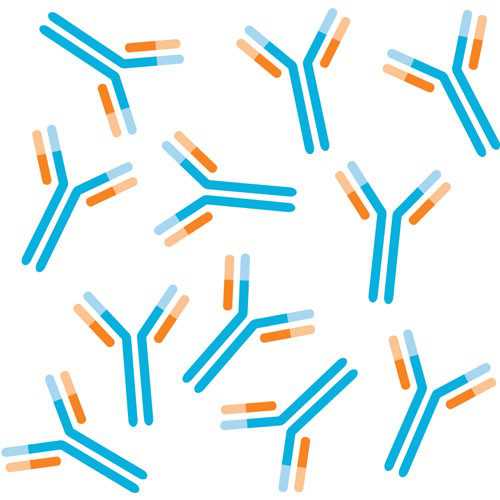Anti-Carboxypeptidase D, C-Terminus Antibody
This polyclonal antibody was generated against a purified His-tagged 20 kDa C-terminal fragment of CPD (aa 1169 – 1347) expressed in E. Coli and is specific for the C-terminal 179 amino acids of human and mouse CPD.
Carboxypeptidase D (CPD) is a membrane glycoprotein with a single hydrophobic transmembrane anchor near the C-terminus and three tandem carboxypeptidase homology domains. Domains 1 and 2 are catalytically active but domain 3 is not. CPD cleaves only C-terminal Arg or Lys residues from proteins and has an acidic pH optimum of ~ 6.0. CPD is ubiquitously expressed and is especially high in macrophages. CPD is predominantly localized in the trans-Golgi and is involved in peptide and protein processing in the constitutive secretory pathway after initial furin cleavage and is also involved in processing microbial toxins such as Pseudomonas exotoxin. Drosophila lacking CPD die in the larval stage and CPD is an important target gene of TGF-ß in macrophages that is downregulated in lupus erythematosus. CPD-mediated generation of L-Arg enhances iNOS-dependent NO generation in mouse macrophages and promote NO production and cell survival in breast cancer cells.
From the laboratory of Randal A. Skidgel, PhD, University of Illinois at Chicago.
 Part of The Investigator's Annexe program.
Part of The Investigator's Annexe program.
This polyclonal antibody was generated against a purified His-tagged 20 kDa C-terminal fragment of CPD (aa 1169 – 1347) expressed in E. Coli and is specific for the C-terminal 179 amino acids of human and mouse CPD.
Carboxypeptidase D (CPD) is a membrane glycoprotein with a single hydrophobic transmembrane anchor near the C-terminus and three tandem carboxypeptidase homology domains. Domains 1 and 2 are catalytically active but domain 3 is not. CPD cleaves only C-terminal Arg or Lys residues from proteins and has an acidic pH optimum of ~ 6.0. CPD is ubiquitously expressed and is especially high in macrophages. CPD is predominantly localized in the trans-Golgi and is involved in peptide and protein processing in the constitutive secretory pathway after initial furin cleavage and is also involved in processing microbial toxins such as Pseudomonas exotoxin. Drosophila lacking CPD die in the larval stage and CPD is an important target gene of TGF-ß in macrophages that is downregulated in lupus erythematosus. CPD-mediated generation of L-Arg enhances iNOS-dependent NO generation in mouse macrophages and promote NO production and cell survival in breast cancer cells.
From the laboratory of Randal A. Skidgel, PhD, University of Illinois at Chicago.
 Part of The Investigator's Annexe program.
Part of The Investigator's Annexe program.
| Product Type: | Antibody |
| Antigen: | Carboxypeptidase D (CPD) |
| Accession ID: | O75976 |
| Molecular Weight: | 180 kDa |
| Isotype: | Antiserum |
| Clonality: | Polyclonal |
| Reactivity: | Human, mouse (other species not tested) |
| Immunogen: | purified His-tagged 20 kDa C-terminal fragment of CPD (aa 1169 ? 1347) expressed in E. Coli |
| Species Immunized: | Rabbit |
| Epitope: | C-terminal 179 amino acids |
| Buffer: | Serum |
| Tested Applications: | WB (1:1000 to 1:5000), IF (1:400 to 1:500), IP (150 uL of sample (solubilized membrane or biological fluid), 70 uL of appropriate buffer, 10 uL of antiserum (diluted 1:2)) |
| Storage: | -20C |
| Shipped: | Cold packs |
Effect of cytokines on CPD expression and localization in endothelial cells.

HLMVEC were exposed to vehicle or 5 ng/ml IL-1 and 200 U/ml IFN for 16 h, fixed, and immunostained. CPD (red) immunostaining increased after cytokine treatment. CPD was localized primmarily to the perinuclear/Golgi region. No Golgi staining was seen in cells stained with control normal mouse IgG or normal rabbit serum (not shown). Results are representative of 4 seperate experiments.
Adapted from: Sangsree, S., Brovkovych, V., Minshall, R. D., and Skidgel, R. A. Kininase I-type carboxypeptidases enhance nitric oxide production in endothelial cells by generating bradykinin B1 receptor agonists. (2003) Am J Physiol Heart Circ Physiol 284, H1959-1968.
- McGwire, G. B., Tan, F., Michel, B., Rehli, M., and Skidgel, R. A. Identification of a membrane-bound carboxypeptidase as the mammalian homolog of duck gp180, a hepatitis B virus-binding protein. (1997) Life Sci. 60, 715-724.
- Tan, F., Rehli, M., Krause, S. W., and Skidgel, R. A. Sequence of human carboxypeptidase D reveals it to be a member of the regulatory carboxypeptidase family with three tandem active site domains. (1997) Biochem. J. 327, 81-87.
- Hadkar, V., and Skidgel, R. A. Carboxypeptidase D is up-regulated in RAW 264.7 macrophages and stimulates nitric oxide synthesis by cells in arginine-free medium. (2001) Mol. Pharmacol. 59, 1324-1332.
- Sangsree, S., Brovkovych, V., Minshall, R. D., and Skidgel, R. A. Kininase I-type carboxypeptidases enhance nitric oxide production in endothelial cells by generating bradykinin B1 receptor agonists. (2003) Am J Physiol Heart Circ Physiol 284, H1959-1968.
- Skidgel, R. A., and Erdös, E. G. Cellular carboxypeptidases. (1998) Immunol. Rev. 161, 129-141.
If you publish research with this product, please let us know so we can cite your paper.


